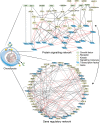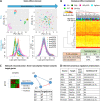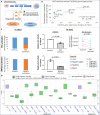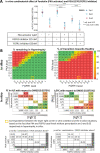An integrated in silico-in vitro approach for identifying therapeutic targets against osteoarthritis
- PMID: 36352408
- PMCID: PMC9648005
- DOI: 10.1186/s12915-022-01451-8
An integrated in silico-in vitro approach for identifying therapeutic targets against osteoarthritis
Abstract
Background: Without the availability of disease-modifying drugs, there is an unmet therapeutic need for osteoarthritic patients. During osteoarthritis, the homeostasis of articular chondrocytes is dysregulated and a phenotypical transition called hypertrophy occurs, leading to cartilage degeneration. Targeting this phenotypic transition has emerged as a potential therapeutic strategy. Chondrocyte phenotype maintenance and switch are controlled by an intricate network of intracellular factors, each influenced by a myriad of feedback mechanisms, making it challenging to intuitively predict treatment outcomes, while in silico modeling can help unravel that complexity. In this study, we aim to develop a virtual articular chondrocyte to guide experiments in order to rationalize the identification of potential drug targets via screening of combination therapies through computational modeling and simulations.
Results: We developed a signal transduction network model using knowledge-based and data-driven (machine learning) modeling technologies. The in silico high-throughput screening of (pairwise) perturbations operated with that network model highlighted conditions potentially affecting the hypertrophic switch. A selection of promising combinations was further tested in a murine cell line and primary human chondrocytes, which notably highlighted a previously unreported synergistic effect between the protein kinase A and the fibroblast growth factor receptor 1.
Conclusions: Here, we provide a virtual articular chondrocyte in the form of a signal transduction interactive knowledge base and of an executable computational model. Our in silico-in vitro strategy opens new routes for developing osteoarthritis targeting therapies by refining the early stages of drug target discovery.
Keywords: Chondrocyte hypertrophy; Computational modeling; Drug targets; In vitro validation; Network of signal transduction; Osteoarthritis; Regulatory network inference; Virtual cell.
© 2022. The Author(s).
Conflict of interest statement
The authors declare that they have no conflicts of interest.
Figures






Similar articles
-
The Regulatory Role of Signaling Crosstalk in Hypertrophy of MSCs and Human Articular Chondrocytes.Int J Mol Sci. 2015 Aug 14;16(8):19225-47. doi: 10.3390/ijms160819225. Int J Mol Sci. 2015. PMID: 26287176 Free PMC article. Review.
-
Consequences of chondrocyte hypertrophy on osteoarthritic cartilage: potential effect on angiogenesis.Osteoarthritis Cartilage. 2013 Dec;21(12):1913-23. doi: 10.1016/j.joca.2013.08.018. Epub 2013 Aug 22. Osteoarthritis Cartilage. 2013. PMID: 23973427
-
A novel fibroblast growth factor receptor 1 inhibitor protects against cartilage degradation in a murine model of osteoarthritis.Sci Rep. 2016 Apr 4;6:24042. doi: 10.1038/srep24042. Sci Rep. 2016. PMID: 27041213 Free PMC article.
-
Effects of shear stress on articular chondrocyte metabolism.Biorheology. 2000;37(1-2):95-107. Biorheology. 2000. PMID: 10912182 Review.
-
ECHO, the executable CHOndrocyte: A computational model to study articular chondrocytes in health and disease.Cell Signal. 2020 Apr;68:109471. doi: 10.1016/j.cellsig.2019.109471. Epub 2019 Dec 11. Cell Signal. 2020. PMID: 31837466
Cited by
-
The effect of allyl isothiocyanate on chondrocyte phenotype is matrix stiffness-dependent: Possible involvement of TRPA1 activation.Front Mol Biosci. 2023 Mar 16;10:1112653. doi: 10.3389/fmolb.2023.1112653. eCollection 2023. Front Mol Biosci. 2023. PMID: 37006615 Free PMC article.
-
A multi-model approach identifies ALW-II-41-27 as a promising therapy for osteoarthritis-associated inflammation and endochondral ossification.Heliyon. 2024 Dec 4;10(23):e40871. doi: 10.1016/j.heliyon.2024.e40871. eCollection 2024 Dec 15. Heliyon. 2024. PMID: 39717596 Free PMC article.
-
Immune digital twins for complex human pathologies: applications, limitations, and challenges.NPJ Syst Biol Appl. 2024 Nov 30;10(1):141. doi: 10.1038/s41540-024-00450-5. NPJ Syst Biol Appl. 2024. PMID: 39616158 Free PMC article. Review.
-
Mathematical modelling of inflammatory process and obesity in osteoarthritis.PLoS One. 2025 Jun 2;20(6):e0323258. doi: 10.1371/journal.pone.0323258. eCollection 2025. PLoS One. 2025. PMID: 40455878 Free PMC article.
-
Digital twins as global learning health and disease models for preventive and personalized medicine.Genome Med. 2025 Feb 7;17(1):11. doi: 10.1186/s13073-025-01435-7. Genome Med. 2025. PMID: 39920778 Free PMC article. Review.
References
-
- Karsdal MA, Michaelis M, Ladel C, Siebuhr AS, Bihlet AR, Andersen JR, et al. Disease-modifying treatments for osteoarthritis (DMOADs) of the knee and hip: lessons learned from failures and opportunities for the future. Osteoarthr Cartil. 2016;24:2013–2021. - PubMed
-
- Von Der Mark K, Kirsch T, Nerlich A, Kuss A, Weseloh G, Glückert K, et al. Type x collagen synthesis in human osteoarthritic cartilage. indication of chondrocyte hypertrophy. Arthritis Rheum. 1992;35:806–811. - PubMed
Publication types
MeSH terms
LinkOut - more resources
Full Text Sources
Medical
Research Materials

